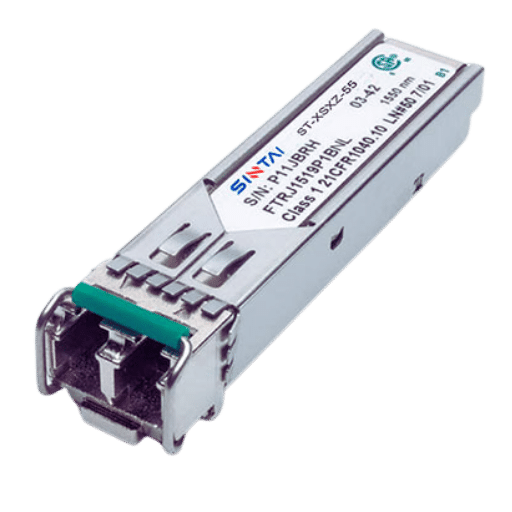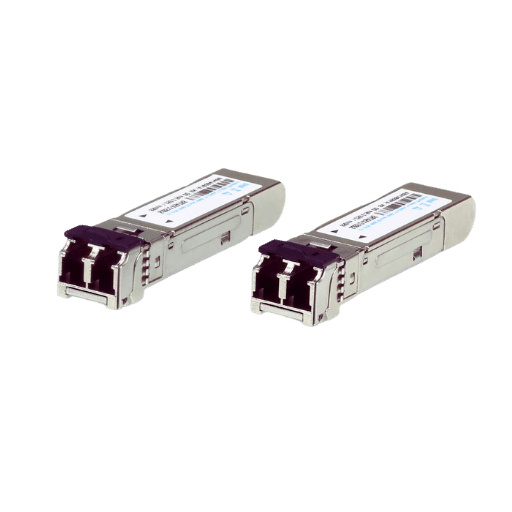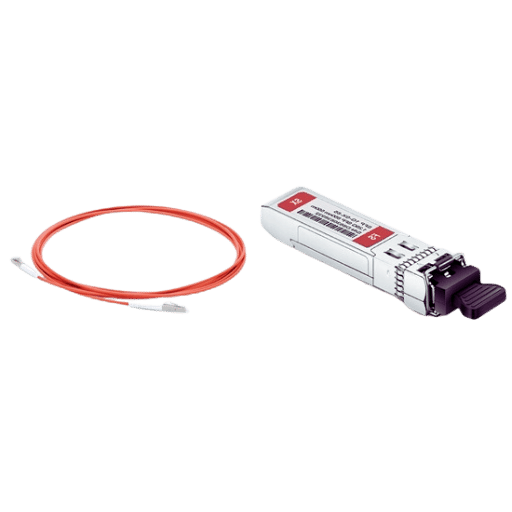Considering the dynamic nature of network infrastructure, multimode Small Form-factor Pluggable (SFP) modules have emerged as a critical component to improve bandwidth, scalability, and overall network performance. These small form factor hot-swappable devices are designed specifically for telecommunications and data communications applications, providing flexible solutions that can support high data rates and many network connections in complex network environments. The purpose of this article is to give a full overview of multimode SFP modules, highlighting their function, benefits, and strategic usage in today’s network designs. When these modules are used well by companies, they help them improve their networks’ efficiency, dependability, and future-proofing capabilities as new technologies emerge.

The Small Form-factor Pluggable (SFP) module is the new generation of optical modular transceivers. They are intended to support different communication standards, including Ethernet and Fibre Channel, among others. The “multimode” part describes what type of fiber optic cable can be used with an SFP. Multimode fibers don’t carry light directly through them like single-mode fibers do, but can transmit multiple light paths or modes that may bounce off the walls of the fiber. This makes it possible for data to be transmitted over shorter distances (up to 550 meters in the case of Ethernet), making multimode SFP modules applicable within data centers or intra-campus communication where high-speed data transfer rates are required but at relatively short distances. Because of their compatibility and support for various networking standards as well as speeds, multimode SFP modules serve as building blocks for scalable and flexible network infrastructures.
The design of modern optical fiber networks relies heavily on multimode SFP modules because they allow for high speed data transmission over short distances. Data centers, office buildings, and campus networks especially benefit from these modules, which provide rapid, smooth network connections between servers, switches, and storage devices. Multimode SFPs greatly improve bandwidth capacity without requiring a whole new network infrastructure by exploiting the ability of multimode fibers to carry several light signals at once. They can be deployed easily and scaled up instantly to allow network systems to keep pace with increasing data requirements as well as advancing technologies while still being cost-effective and energy-efficient due to their plug-and-play designs.
Some of the important characteristics and advantages of multimode SFP modules are:

The main difference between single-mode and multimode fibers is their core sizes and how light beams pass through them. Single-mode fibers have a small core (around 9 micrometers in diameter) that only lets one mode of light propagate directly down the fiber, reducing dispersion and thus allowing data to travel further at greater bandwidths. On the other hand, multimode fibers possess larger cores (typically 50 or 62.5 micrometers), permitting many light modes to bounce and reflect along the path – this is suitable for short-distance transmission because of modal dispersion. These physical characteristics lead to operational variations; single-mode fibers are best used for long-haul telecommunications systems as well as high-capacity links while multi-mode fibres are employed over short distances like within data centres or LANs where more bandwidth is needed over less distance.
Single-Mode SFP modules can handle communication needs that go beyond kilometers, such as wide area network (WAN) connections, metropolitan area network (MAN) links or even cable television networks. They are fitted for telecommunication companies and big corporations with a wide geographical coverage because they can send data over long distances without losing much of it.
Meanwhile, multi-mode SFP modules are designed to transmit data over short distances, which makes them suitable for use within data centers, local area networks (LANs), and connecting servers to switches, among others. This is because their larger core allows multiple light modes to bounce off and reflect, thus making them best suited for high-bandwidth applications over shorter distances, generally up to one kilometer, where speed and volume of data transfer are critical, but the distance is relatively limited.
The decision of whether to use single-mode or multimode SFP modules for your network depends on distance, speed and budget. When it comes to long-haul transmissions where the distance is key, single-mode SFPs are recommended as they can send data through tens of kilometers without losing much signal quality. Conversely, in short distances like those found within a data center or LAN (local area network) setting among others; multi mode SFPs become cheaper and better suited since they allow for higher data rates over shorter links. It is also important that this choice reflects scalability in line with future demands placed on your network structure.

The multimode SFP modules are commonly operated at a wavelength of 850nm because they provide the best balance between performance and cost-effectiveness for short-range data transmission applications. The fast transfer of data is made possible by this particular wavelength, which is ideal for use in high-density data traffic environments such as data centers or LANs. Additionally, these modules employ VCSEL (Vertical Cavity Surface Emitting Laser) technology at 850 nm, which not only saves money over longer wavelength lasers but also allows quick modulation necessary to achieve high-speed communication across short distances. For this reason, among others, 850nm SFP modules have become an industry standard wherever bandwidth is needed, most urgently over limited reach in modern network infrastructures confined within space constraints.
In order to make them more identifiable and reduce mistakes while dealing with the rapid pace of network setups, fiber optic cables and SFP modules are standardized by color. The modes and capacities of these cables or modules are indicated by three main colors; orange, aqua and yellow. Normally, orange is used for multimode fibers such as OM1 or OM2, which are commonly employed in low-range transmission systems. Aqua is meant for OM3 or OM4 cables used within multi-mode applications where there is a need for higher bandwidths over longer distances, while yellow indicates single-mode fibers that can transmit information to much further locations than those covered by multi-mode ones. This system of color coding makes it easier to install and maintain networks, as well as prevent expensive errors caused by mismatching cable types with network devices.

To effectively and efficiently use multi-mode SFP (Small Form-factor Pluggable) modules in a fiber optic network, it is important to match the modules with the right type of multi-mode fiber optic cabling. Multi-mode fiber (MMF) comes in various classifications, such as OM1, OM2, OM3, and OM4, each of which supports transmissions over different distances at different bandwidths. For example, 850nm SFP modules work best with short-range communication fibers such as OM1 and OM2, whose bandwidths can reach up to 550 meters, thus providing an affordable solution for small and medium-sized businesses. Conversely, higher data rates demand increased bandwidth hence the need for Enhanced Small Form-factor Pluggable (SFP+) modules that can transmit through several hundred meters or even 2 kilometers on OM3 or OM4 fibers designed with this capability in mind. Therefore by ensuring that appropriate grades of multi-mode fibers are used together with corresponding SFP types not only guarantees efficiency but also prevents signal loss, which may cause integrity problems within data, leading to failure in communication reliability coupled with performance enhancement across networks themselves.
Once these instructions are carefully observed, the successful installation of multimode Sfp transceivers will be assured, thus creating more efficient, high-performing networks.
The system’s performance might be affected by several common mistakes when deploying multimode SFP modules. To start with, ensuring that the SFP module is compatible with the networking equipment is important because using modules that are not compatible can prevent connection establishment. Secondly, people often overlook the standard and quality of fiber optic cables they use. Such a cable may lower signal quality significantly than expected if it happens to be a poor-quality one or an inappropriate type like a single-mode cable being used in combination with multimode SFPs. Thirdly, inadequate cleaning practices for connectors and module ports can cause either signal loss or interference. Moreover, environmental conditions around where these modules have been positioned should never be ignored because extreme temperature variations, humidity levels or dust particles could interfere with their working ability. In conclusion, best practices during selection, installation, and maintenance should be followed so as to avoid any of these pitfalls, thereby making your multi-mode SFP deployment reliable and efficient at all times.

Cisco Systems, Inc. is a leader in networking technology with their various Small Form-factor Pluggable (SFP) modules for high-performance Gigabit Ethernet. They have many multimode SFPs that are designed for enterprise and carrier-grade environments where reliability, compatibility, and performance are needed most. Among these products, two stand out: the Cisco GLC-SX-MMD module and the Cisco GLC-LH-SMD module, which can support different types of optical fibers over various distances while still being technologically advanced. To make sure network administrators can effectively manage and diagnose network performance issues, these modules feature Digital Optical Monitoring (DOM), among other things. Moreover, no other company has such good customer support or produces such high-quality goods as Cisco does; therefore, if you integrate these into your infrastructure, there will be no problems with connectivity because they work well for all current and future gigabit ethernet needs, too!
If you want to consider high-performance multimode Small Form-Factor Pluggable (SFP) for Gigabit Ethernet connectivity, there are several important parameters that need to be understood so as not to hinder network efficiency, compatibility, and durability. Here they are:
These parameters should be carefully considered by network professionals during the evaluation of multi-mode SFP modules for selection purposes that are in line with their specific needs, thus ensuring a high-performance, resilient, and scalable Gigabit Ethernet connectivity solution.

The design of multimode SFP modules and the kind of optical fiber used affects their distance capabilities. In general, they can handle Ethernet communications over distances ranging between one hundred meters and two kilometers. Also, the fiber’s category (OM1, OM2, OM3 or OM4) sets a limit to how far the signal can travel; for instance, signals sent through OM4 will reach further due to its wider bandwidth. Nevertheless, these figures are subject to change depending on factors such as fiber quality in terms of purity or attenuation loss ratio; connection type – whether it is SC/ST/FC/LC, etc.; wavelength at which light travels along a particular link within network infrastructure components like switches/routers/gateways/optical amplifiers, etc.. For best results in terms of maximum coverage without compromising data integrity during the transmission process, choose the appropriate multimode fiber type based on module specification.
To improve performance and expand the scope of multimode SFP connections, we need to adopt the following steps:
By following these hints, you will significantly increase your multi mode small form factor pluggable module connection’s range and performance hence creating a strong reliable network.
The emergence of 10-gigabit multimode small form-factor pluggable (SFP) transceivers marks a breakthrough in overcoming historical speed barriers of optic fiber networks. These gadgets meet the need for more bandwidth in enterprise and data center environments through simultaneous transmission at 10Gbps over multiple-mode fibers. Besides being faster, 10G SFPs are also energy-saving since they minimize delays when handling large volumes of data or communicating at high speeds. In addition, these devices can work with existing infrastructures thereby saving costs that would be incurred during complete system replacement while still providing an upgrade path that is affordable. Businesses should, therefore, integrate this technology into their networks as it greatly improves performance capacity; this allows for future development and caters to the growing demand posed by modern applications, which require higher amounts of information to be processed at faster rates.
A: In the field of data communication and networking, a multimode SFP (small form-factor pluggable) transceiver exists for short-distanced connections that employ multi-mode optical fiber cable. It differs from a single-mode SFP, which is used for long-distance communication, mainly because of the core size of the fiber optic used. Multimode fibers allow signals to travel in many different paths, unlike single-mode fibers through which only one direction is possible, thereby giving higher transmission rates and enabling longer distances to be covered. The majority of Multimode SFPs operate at an 850nm wavelength with LC duplex connectors capable of supporting speeds up to 1.25 Gbps over distances as far as 550m, depending on which type of model you choose and what kind of OM3 glass you have.
A: If your device is MSA (Multi-Source Agreement) compliant, then generally, yes, multi-mode sfp transceivers are compatible with any sfp port. Nonetheless, the hardware specifications must match those in the sfp module in terms of data rate, wavelength and fiber type as well as ensure proper functioning. Check out the compatibility list for hardware or contact the manufacturer.
A: No, it is not advisable to use multimode SFP module on single mode fiber network. Multimode sfp transceivers are meant to be used on multi-mode fibres which have larger core diameters than single mode fibres.As such, trying to use multimode SFP’s on single mode fiber will result in data transmission errors as well as reduced performance due to mismatch between cores sizes.
A: The benefits of using multimode SFP transceivers include their low cost for short transmission, their interchangeability and expandability, and compatibility with a wide range of network equipment. They can be used for things like running gigabit sfp in-building or campus backbones where distances are relatively short and high bandwidth is required.
A: According to the article, such devices as these “MSA compliant” devices are defined as multimode SFP transceivers that meet the Multi-Source Agreement specifications, which are standards agreed upon by multiple manufacturers to ensure interconnectivity between different brands of networking gear. A plug-in MSA-compliant module of transceiver has a uniform physical size, connectors, optical characteristics, and electrical interface, among other specifications, so that it can function across other devices also designed under the umbrella standards by MSA.
A: Multiple factors need consideration when choosing an appropriate type of multimode SFP transceiver, including required data rate, optical cable type (e.g., OM1, OM2, OM3, or OM4), distance signal needs to travel for optical transmission link, and wavelength needed (usually 850nm for multi-mode). Also important is whether it is an MSA-compliant transceiver / if it will work with your equipment. In addition, always seek advice from manufacturers/hardware vendors who will help you make an informed decision based on all model’s suitability.
A: The possibility exists for utilizing multi-mode gigabit ethernet modules as well as fiber channel applications with multi-mode fiber optics SFP in case they can support the specifications of the given application, e.g., data rate, distance, and cable type. For optimal performance and compatibility reasons, one should select an sfp module as per his/her needs while setting out to source for one.
A: Whenever you are connecting multimode SFP transceivers with fiber patch cords, there are several things that must not be overlooked; these include, for instance, fiber optic cable (OM1, OM2, OM3, or OM4), core size and connector type (LC usually). The patchcord must match the multimode specifications of the transceiver and the network equipment. Furthermore, there is a need to ensure the correct polarity and cleanliness of connectors so that signal integrity, as well as performance, are preserved.